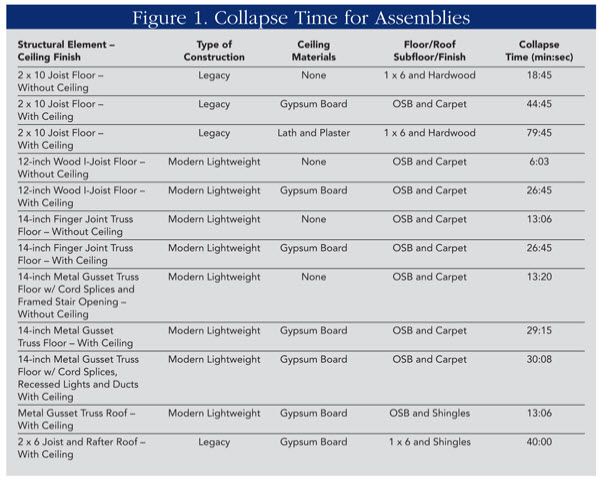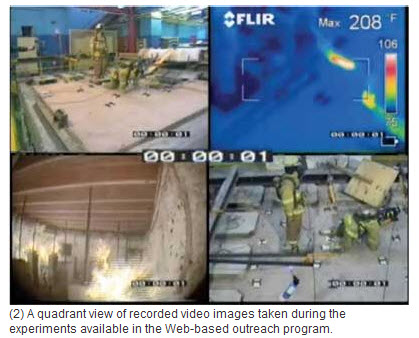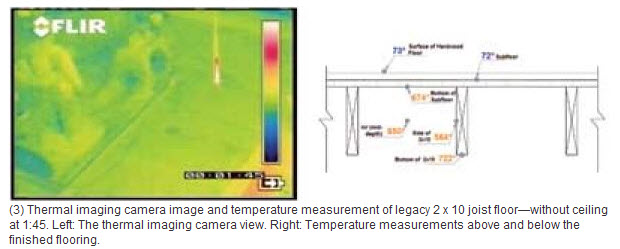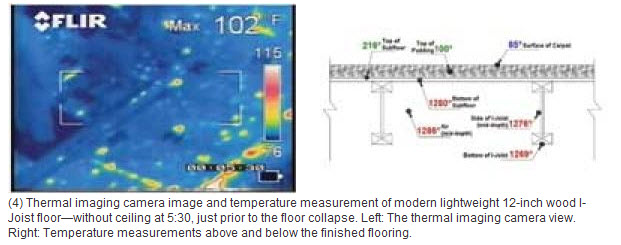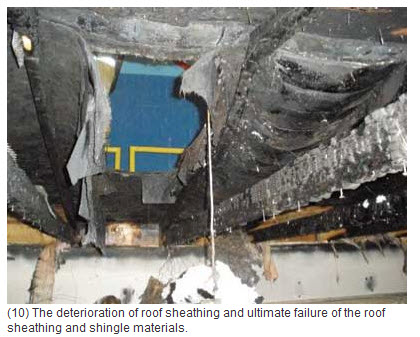Structural Collapse: The Hidden Dangers of Residential Fires
By Christopher J. Naum, SFPE on Jan 14, 2011 with Comments 0
Structural Collapse: The Hidden Dangers of Residential Fires
Oct 1, 2009 Originally Published in FireEngineering.com, All Rights Reserved
By James M. Dalton, Robert G. Backstrom, and Steve Kerber
Educational Objectives
1 Gain an understanding of the behavioral differences between solid wood joist and lightweight wood structural members under fire attack.
2 Gain an understanding of the American Society for Testing and Materials (ASTM) E119 test used to establish structural fire resistance, with modified loading conditions.
3 Gain knowledge concerning the collapse times of various floor and roof assemblies in tests recently conducted by Underwriters Laboratories (UL).
4 Gain an understanding of the benefits of 1⁄2-inch gypsum board applied to the underside of an assembly, delaying collapse.
Between 1997 and 2008, 26 firefighters lost their lives in residential building collapses. The ensuing National Institute for Occupational Safety and Health (NIOSH) investigations highlighted the impact of rapid fire spread through areas of unprotected wood construction, the collapse of unprotected dimensional lumber, and the collapse of lightweight engineered wood components. In addition, departments nationwide have experienced countless near-miss incidents. Recent initiatives such as the National Fire Fighter Near-Miss Reporting System have documented more than 80 reports of incidents involving lightweight and truss construction.
In response to a growing number of line-of-duty deaths and injuries from fires involving engineered lumber, Underwriters Laboratories, Inc. (UL), in partnership with the Chicago Fire Department (CFD) and the International Association of Fire Chiefs (IAFC), was awarded funding from the Department of Homeland Security (DHS)/Federal Emergency Management Agency’s (FEMA) Assistance to Firefighters Grant (AFG) program to investigate this disturbing trend and better understand the hazards firefighters face in residential buildings constructed with lightweight and wood construction.
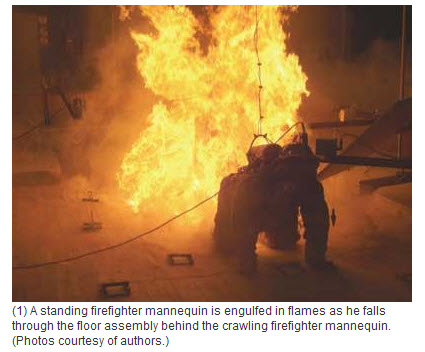 Residential buildings are increasingly replacing conventional solid joist construction with modern lightweight construction, such as lightweight wood trusses and engineered I-joists, in roof and floor designs. These modern construction components have the same or better load-carrying capacities but don’t perform as well under fire conditions mainly because there is less wood to burn. The comparison of this performance was the focus of this test series.
Residential buildings are increasingly replacing conventional solid joist construction with modern lightweight construction, such as lightweight wood trusses and engineered I-joists, in roof and floor designs. These modern construction components have the same or better load-carrying capacities but don’t perform as well under fire conditions mainly because there is less wood to burn. The comparison of this performance was the focus of this test series.
The experimental series consisted of 12 furnace fire tests of assemblies representative of typical residential “legacy” and “modern” floor and roof construction. The tests included six structural elements, three ceiling finish configurations, four floor or roof finishes, and one test examining finished ceiling penetrations (Figure 1). All of the test assemblies conformed to the dimensions and span of the available test furnace (14 feet by 17 feet). The structural members tested spanned 14 feet, even though some of the assemblies are capable of spanning greater distances because of either the material strength or joist depth of the floor or roof assembly being tested. Some the spans for these tests are conservative; view resulting failure times with this in mind. Had the structural members been allowed to support loads for a longer span, the resulting failure times would have been potentially accelerated, thus reducing the collapse time for the assembly. Measurements taken during each experiment include observation of the conditions of the ceiling and floor or roof surfaces, temperatures in the concealed space above the ceiling membrane, deflections of the floor and roof surfaces, and failure times of the tested assemblies.
This research conformed to the standard requirements of the ASTM E119, Fire Tests of Building and Construction Materials, testing method with one exception: the floor and roof loading requirements. The ASTM E119 testing method is normally used to certify fire resistive construction. This test series used this accepted ASTM E119 testing method to evaluate the performance of nonfire rated floor and roof construction found in legacy and modern residential construction. The current model building codes do not require fire resistance ratings for these floor and roof assemblies.
The standard set by ASTM E119 describes a fire test method that establishes a benchmark fire resistance performance between different types of building assemblies. This test relies on a standardized fire and time temperature curve, which is intended to represent a fully developed contents fire within a residential or commercial structure with temperatures reaching 1,000ºF at five minutes and 1,700ºF at 60 minutes. The ASTM E119 fire endurance test is designed to express fire resistance ratings in terms of hours: 1⁄2-hour, one-hour, two-hour, three-hour, and four-hour rated assemblies.
These hourly time ratings are not intended to convey the actual time a specific component or assembly will withstand a real fire event. All fires are different. Variations result from room size, combustible content, and ventilation conditions. The ASTM E119 test method is designed to provide a useful benchmark for building code officials and fire protection engineers, enabling a comparison of fire performance between test samples within the laboratory environment.
Typically the ASTM E119 test procedure requires a larger, uniformly applied load to the floor designed to fully stress, or almost fail, all supporting structural members. This ultimate design load is generally higher than the uniform live load of 40 pounds per square foot (lb/ft2) prescribed by the current model building codes for residential construction. The average home with furniture arranged in a room is usually actually carrying live loads below the prescribed design live load of 40 lb/ft2. To represent the average home with furniture around the perimeter of the room, a load of 40 lb/ft2 was placed along two of the four sides of the floor to represent the typical conditions a firefighter encounters when entering a structure fire. To represent fire service personnel, the assemblies were also loaded with two mannequins, each outfitted in fire gear and weighing 300 pounds, placed in the center of the floor or roof assembly. For the two tests that represented roof-ceilings assemblies, the two mannequins were the only live loads applied to the test assemblies.
The collapse times for all of the assemblies are shown in Figure 1. In addition to the collapse times, a large amount of significant useful data for the fire service was obtained during these fire tests, including the observation of the conditions of the ceiling and floor or roof from both sides of the assembly, temperatures in the concealed spaces, deflections of the floor and roof surfaces prior to collapse, thermal imaging camera (TIC) video from the top of the assembly, and video and audio recordings from the simulated firefighters’ perspectives.
All of this information could not be included in a single article or report, so it has been developed into a Web-based outreach program for the fire service. This free interactive program is at www.ul.com/fire/structural.html.
IMPORTANT FINDINGS
Important study findings include the following:
Floor collapse in six minutes. Engineered wood floor assemblies have the potential to collapse very quickly under well-ventilated fire conditions. When it comes to lightweight construction, there is no margin of safety. There is less wood to burn and, therefore, potentially less time to collapse. The results of tests comparing the fire performance of conventional and modern construction will improve the understanding of the hazards of lightweight construction and help incident commanders, company officers, and firefighters to evaluate the fire hazards present during a given incident and allow a more informed risk-benefit analysis when assessing life safety risks to building occupants and firefighters.
The fire environment has changed. The size-up of any given structure is, for the most part, based on previous fireground experiences; most of that experience comes from fighting fires in the homes of yesterday, fairly robust 1,500-square-foot legacy-type homes constructed with solid dimensional lumber. But today, as more homes are constructed with lightweight materials, traditional size-up techniques may not provide proper risk assessment. Whether an existing renovated home or a newly constructed “McMansion,” these modern homes are the new reality.
Many of today’s typical house fires are in buildings that could readily be categorized as commercial structures with commercial fuel loads. The increased size of these buildings, use of large unprotected areas of lightweight construction, and resulting fires from modern synthetic fuel loads have proven to be catastrophic. Today’s fireground operations must reflect this new reality. Adequate personnel must be dispatched and available to ensure that basic fireground operations can be completed in a safe and timely manner. Fires in today’s modern homes may require the need for additional personnel; consider the escalation of alarms early in the operation.
Thermal imaging cameras do not provide an adequate indication of a weakened floor or pending collapse. There is a potentially dangerous misconception in the fire service that TICs can detect fire on the floor below or above a firefighter. TICs detect variations in surface temperatures for objects in the field of vision. They cannot detect temperatures if the camera is thermally shielded by the finish materials of a floor or ceiling, such as carpet or gypsum board. Average temperatures below the assembly were in excess of 1,200°F while average temperatures on top of the carpet were less than 100°F. The application of water during suppression operations will also further mask these thermal signatures in the TIC camera’s field of vision during suppression operations.
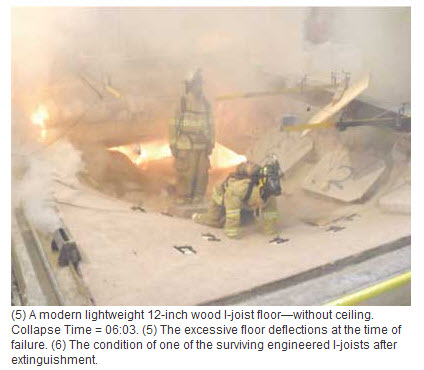 The structural performance of floor systems. Currently accepted testing standards used in the United States, such as the ASTM E119 conditions of acceptance, recognize a collapse, or structural floor failure, as one of the acceptance criteria linked to the failure time of a tested assembly. The ASTM E119 definition of collapse requires the floor to totally collapse within the furnace.
The structural performance of floor systems. Currently accepted testing standards used in the United States, such as the ASTM E119 conditions of acceptance, recognize a collapse, or structural floor failure, as one of the acceptance criteria linked to the failure time of a tested assembly. The ASTM E119 definition of collapse requires the floor to totally collapse within the furnace.
Several fire test standards recognized outside the United States, similar to ASTM E119, such as the International Organization for Standardization (ISO) 834:1 Fire-resistance tests—Elements of building construction—Part 1 do not rely solely on collapse as an indication of the floor’s strength. The ISO general requirements define load-bearing capacity as the elapsed time that a test sample is able to maintain its ability to support the applied load during the fire test.
The ability to support the load, as defined by the standard, monitors the potential for a complete structural failure and/or when a floor is significantly weakened. This standard takes into account when a floor is progressively deflecting or failing prior to a complete structural collapse. Identifying when a floor has been significantly damaged or weakened is a critical piece of information for the fire service.
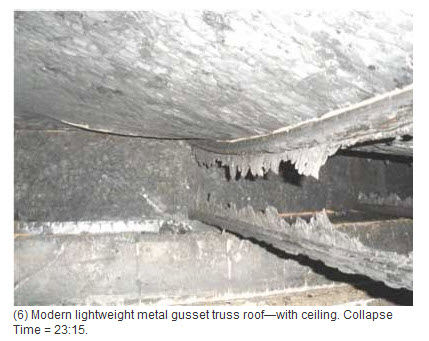 A review of the ASTM E119 and ISO 834:1 failure times as they apply to the unprotected (without ceiling) engineered wooden I-joist assembly clearly illustrates that the floor had become significantly damaged and lost its ability to carry load far before the actual total collapse time. If the ISO standard was applied to the unprotected engineered wooden I-joist assembly, the accepted failure time would change from 06:03 (acceptance criteria time per the ASTM E119 standard) to 04:00 (load-bearing capacity per the ISO 834:1 standard).
A review of the ASTM E119 and ISO 834:1 failure times as they apply to the unprotected (without ceiling) engineered wooden I-joist assembly clearly illustrates that the floor had become significantly damaged and lost its ability to carry load far before the actual total collapse time. If the ISO standard was applied to the unprotected engineered wooden I-joist assembly, the accepted failure time would change from 06:03 (acceptance criteria time per the ASTM E119 standard) to 04:00 (load-bearing capacity per the ISO 834:1 standard).
For the fire service, this means that a complete collapse of this floor would have been seen at 06:03 but that the floor would have been severely compromised and potentially unsafe to operate on at 04:00. Be aware that although these testing methods provide documented research failure times, they also illustrate that the floors have become dangerous far before the actual documented collapse times. This trend was consistent throughout the engineered lumber assemblies tested within this study. These failures in real-life incidents may also be accelerated by larger fire loads and variations in field conditions.
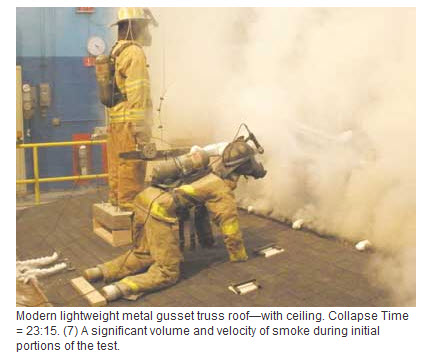 Structural performance of the roof assemblies. This research also conducted two roof tests respective of finished ceiling/attic assemblies representing both “legacy” and “modern” construction. The evaluation of the structural performance of these assemblies and components was limited because of the available span of the furnace dimensions with respect to the overall depth of the roof structures. This is a significant limitation as the 2 × 4 metal gusset-plated roof trusses can span distances that far exceed 14 feet.
Structural performance of the roof assemblies. This research also conducted two roof tests respective of finished ceiling/attic assemblies representing both “legacy” and “modern” construction. The evaluation of the structural performance of these assemblies and components was limited because of the available span of the furnace dimensions with respect to the overall depth of the roof structures. This is a significant limitation as the 2 × 4 metal gusset-plated roof trusses can span distances that far exceed 14 feet.
The study, however, did demonstrate a potentially dangerous and misleading ventilation phenomenon regarding installed roof vents. Initially, there was a significant amount of smoke emitting from the continuous plastic ridge vent at the beginning of the modern roof assembly test. As the temperatures increased, the continuous plastic ridge vent melted and collapsed. The collapse of the vent changed the ventilation profile for the roof. The initially heavy smoke pattern emitting from the continuous ridge vent diminished to a light indistinguishable smoke trail, although the fire was still raging below. The excessive heat created by the fire was, in effect, restricted from venting vertically through existing natural openings and created an excessively untenable condition below the roof in the attic and the occupied floor areas below the attic as the ceiling finishes failed.
Teams conducting size-up prior to fireground operations may be deceived by this change in the quantity and velocity of the smoke emitting from the roof structure as they prepare to conduct fireground operations. A confined unventilated fire in an enclosed attic will accelerate the failure of roof structural elements and contribute to the failure of the ceiling materials between the attic and floors below.
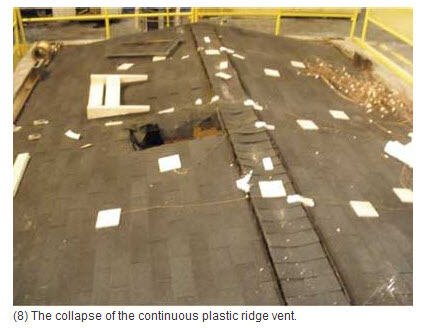 Reduced smoke emitting from existing roof vents gives the wrong impression to roof teams attempting to determine if it is safe or necessary to conduct roof operations. The failure of ceiling finish materials below the attic space can also trap fire crews as fire and heat quickly overtake the floor areas below the attic level.
Reduced smoke emitting from existing roof vents gives the wrong impression to roof teams attempting to determine if it is safe or necessary to conduct roof operations. The failure of ceiling finish materials below the attic space can also trap fire crews as fire and heat quickly overtake the floor areas below the attic level.
There is a lack of residential building code provisions regarding the average single-family residence. Building code and regulatory service groups have only recently identified the fire service as one of the potential user groups for buildings under the existing model building codes. A provision in the 2006 International Building Code, section 101.3, has adopted new language stating that one of the intents of the building code was to “provide safety to firefighters.” However, this code provision, which could offer a possible long-term solution, does not define to what extent the building code in any given jurisdiction adequately satisfies this requirement. Changes to model building codes often occur after a tragic loss of life. Cumulative numbers documented by NIOSH case studies alone justify the need for future changes to existing model building codes. This is especially true for one of the model building code’s most unrestrictive subgroups, the Type V-wood frame or Type III ordinary constructed residential occupancy. The fire resistive requirements for most single-family residential occupancies are minimal with regard to the exterior of the building and virtually nonexistent with regard to the interior floor and roof assemblies.
This research project demonstrated that adding a single layer of 1⁄2-inch gypsum wall board to the bottom of the unprotected floor assembly regardless of legacy or modern construction, a standard method of passive fire protection, can add on average approximately 20 minutes to the collapse time. The addition of passive fire protection requirements in the model building codes for these construction assemblies would protect not only the lives of the first responders, but would provide for the safe egress of the building occupants as well.
For further information on this study, please email Robert.G.Backstrom@us.ul.com, Stephen.Kerber@us.ul.com, or James.Dalton@cityofchicago.org. To submit additional information and/or photos on local fire incidents within your area that may inform the issues discussed within this article, please contact James.Dalton@cityofchicago.org.
Structural Collapse: The Hiden Dnagers of Residential Fires
James M. Dalton is the coordinator of research and development for the Chicago (IL) Fire Department.
Robert G. Backstrom is a senior staff engineer with Underwriters Laboratories Inc.
Steve Kerber is a research engineer with Underwriters Laboratories Inc. and has 12 years firefighting experience.
Filed Under: Anatomy of Buildings • Engineered Systems & Materials • Predictive Occupancy Performance • Research • Research Hub • Structural Systems
